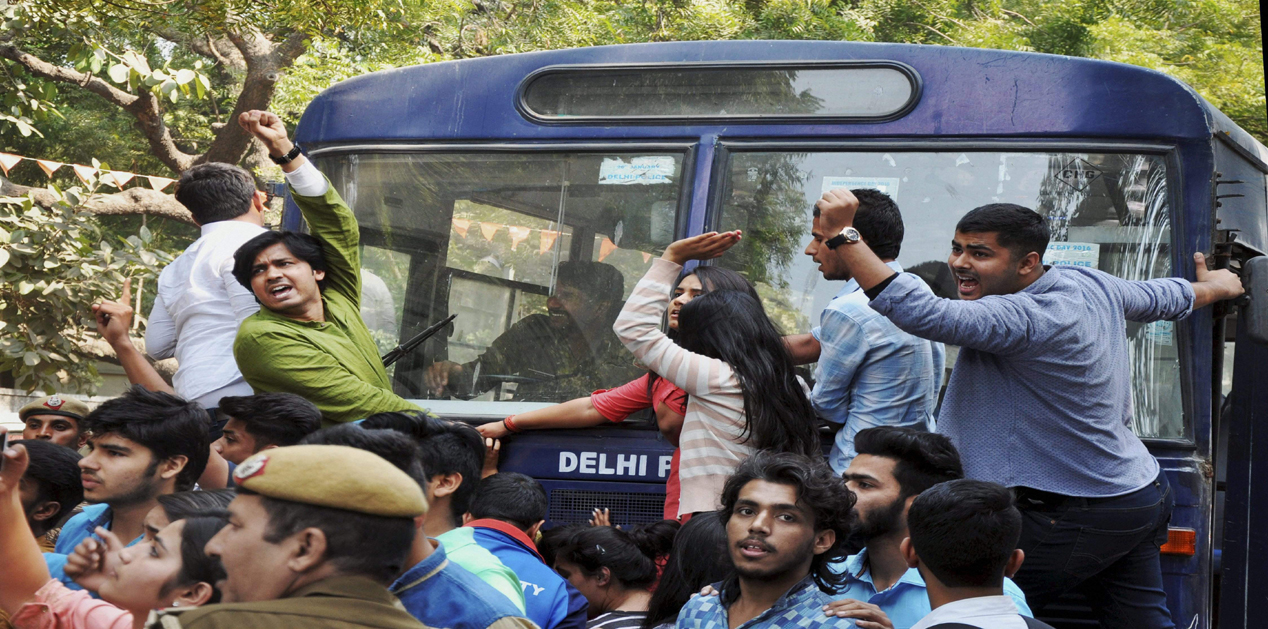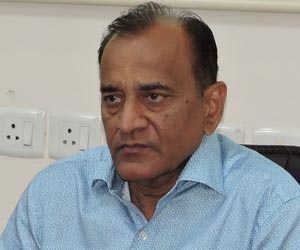The controversy which has erupted at Ramjas College of Delhi University, will take some time to settle down. The narrative has been divided between ‘freedom of speech’ and ‘nationalism’. One had seen a similar incident exploding in Jawaharlal Nehru University (JNU) a year ago. That too is still waiting for a closure. In both cases, allegations of anti-nationalism and denials of the same, are being traded back and forth. It should be easy enough to determine what an anti-national act is: Any statement or action that questions the sovereignty and integrity of the country should be deemed as anti-national. But this still does not settle the matter; the issue remains in the realm of rhetoric. It is more so because the law on being ‘anti-national’ is really a law on sedition, as it exists today. And the law on sedition has so many ifs and buts that there is constant confusion over the definition of this crime.
Besides, few, if any, have actually been convicted for sedition in independent India; terrorists who have been convicted and hanged were tried under the anti-terror laws of the country. Indeed, on quite a few occasions, the courts have in the initial stages of hearing, dismissed charges of sedition brought against the accused, even if they have proceeded to act on other provisions of the Indian Penal Code. This begs two questions: Do we need a stronger law on sedition to handle situations of brazen anti-nationalism that sections of our people indulge in? Do we need to scrap the anti-sedition Act altogether because it is not just dated but also a fetter to free speech that defines a robust democracy?
The concept of ‘free speech’ is itself contentious insofar as its level of freedom is concerned. Do slogans such as “Bharat ki barbadi tak" (until India’s destruction); “Bharat ke tukde, tukde" (dismemberment of India); Afzal hum sharminda hain, tere qaatil jinda hain” (Afzal — hanged terrorist Afzal Guru — we are ashamed that your killers are around and living), qualify as the right to free speech that must not be tampered with? Is this a progression of democracy or an exploitation of the freedom that such democracy offers? The calls for azadi heard at the JNU and now at Ramjas College, and in the Kashmir valley ever so often, are open provocations for the nation’s disintegration.
Nobody is fooled by the explanation that the call for azadi is really a demand for freedom from poverty, socio-economic backwardness, from Government apathy. Why would such slogan-shouting mobs on the streets of Kashmir then be waving flags of Pakistan — and worse, the Islamic State? The latest is azadi for Bastar! The logic offered is that Bastar is a deprived region whose people need freedom from the misery they have been living under. There are many pockets in the country where the fruits of development have not reached for various reasons. But Bastar is infested with Maoists who have tried to gain control over the region through sheer force and violence. In every region that they have a presence in, these ultra-Left elements have blocked progress — whether it be in the area of infrastructure or education or health or employment generation. They want the people to remain deprived and under their control. And the azadi brigade promotes the Maoist agenda.
Besides, it’s not possible to tackle socio-economic deprivation by challenging the nation’s sovereignty and its democratic structure. There are several organisations which work alongside the Government, and even independently, to alleviate the levels of living of the masses. Raising offensive slogans against national integrity and sympathising with terrorists cannot be the way forward. Indeed, elements who do so are only using socio-economic issues as a fig leaf to hide their larger anti-national agenda.
Now, let’s understand the concept of free speech. When the JNU incident broke out a year ago, several senior political leaders from various opposition parties arrived at the university campus to extend their solidarity with students who were up in arms over the action the authorities had taken against those, named and unnamed, who were allegedly involved in anti-India activities. The political leaders had slammed the Government of Prime Minister Narendra Modi for ‘stifling’ free speech, for being ‘Hitlerian’ in its conduct, and for ‘destroying’ the educational fabric. Among the visiting leaders were those from the Congress and the Left parties.
Can the Congress and the Left parties have forgotten that conditions to free speech were introduced in the Constitution of India by Jawaharlal Nehru, a figure which the former reveres and the latter respects? The Constitution (First Amendment) Act, 1951, came to address the ‘abuse of freedom of speech and expression’. Among the many Articles of the newly adopted Constitution that it changed, was Article 19. The citizen’s right to freedom of speech and expressions stands guaranteed under Article 19(1) (a), which reads: “All citizens shall have the right to freedom of speech and expression.” There was also a clause (2), which, after the first amendment, came to be read as follows: “Nothing in sub-clause (a) of clause (1) shall affect the operation of any existing law, or prevent the state from making any law, insofar as such law imposes reasonable restrictions on the right conferred by the said sub-clause in the interest of the security of the state, friendly relations with foreign states, public order, decency or morality, or in relation in contempt of court, defamation or incitement to an offence.” It was then felt that a written Constitution must not leave itself open to misinterpretation by being vague on the issue of free speech, in the sense that free speech is taken to be absolute. In other words, the ‘absoluteness’ character was effectively taken care of through the first amendment of the Constitution.
There is irony in how the Congress and the Left have got together to trash the fetters on free speech vis-a-vis the JNU and the DU episodes. It is widely believed that Nehru piloted the first amendment to the Constitution in response to a Leftist magazine published by Romesh Thapar in the 1950s. The magazine, Crossroads, had launched a scathing attack on certain aspects of the Nehruvian policy and was thereafter banned. Thapar went to the Supreme Court, and what followed came to be known as Romesh Thapar versus the State of Madras case. As a counter, the first amendment was introduced to curb the ‘abuse’ of freedom of speech. There is, of course, a debate now on whether this amendment should be scrapped, or at least amended to include just two factors to restrict free speech: First, if it suppresses the other’s right to free speech; and second, if it leads to violence. The narrative is thus being distilled to the level of ridiculous simplicity: If you support the first amendment, you are illiberal. There can be many reasons to criticise this amendment — it led to the placement of many issues in the Ninth Schedule that could not be challenged, and it perhaps even paved the way for the imposition of Emergency 24 years later — but reasonable restrictions on free speech and expression cannot be one of them.
The law on sedition is more complex and is dealt with under Section 124-A of the Indian Penal Code. The issue of sedition is relevant because a bunch of students including Kanhaiya Kumar had been held on charges of sedition in the JNU unrest case. In the Ramjas College issue too, there is talk that the activities that have been uncovered should be tried under the anti-sedition law. Of course, not all acts of free, or even offensive, speech, are seditious in nature. The jury is still out on whether calls for the nation’s disintegration are seditious in nature. This may sound strange, because prima facie it should be. However, the twist lies in the reading of the IPC Section, which is magnanimous enough to allow many to escape its clutches. Section 124-A lays down the punishment for sedition in the following terms: “Whoever, by words, either spoken or written, or by signs, or by visible representation, or otherwise, brings or attempts to bring into hatred or contempt, or excites or attempts to excite disaffection towards the Government established by law in India”, shall get life imprisonment.
The attempt to cover all actions, direct or indirect, is interesting, but what dilutes the Section is the later understanding that such actions must lead to violence or incitement to violence. Six months ago, the apex court had referred to the 1962 Kedar Nath Singh versus State of Bihar case, and said that Section 124-A would stand only if the actions of the accused lead to violence or incitement to violence. The court in the Kedar Nath case had said, “Citizen has a right to say or write whatever he likes about the Government, or its measures, by way of criticism or comment, so long as he does not incite people to violence against the Government established by law or with the intention of creating public disorder.” The Supreme Court had gone back to the 54-year old case in the backdrop of sedition cases being filed against Amnesty International following a meeting it had held on the Kashmir issue and against actor-turned-politician Ramya’s remarks on Pakistan.
With the right to free speech and expression being taken to extremes by secessionists and their sympathisers, including the Left-liberal intelligentsia, it is not surprising that the clamour for the repeal of Section 124-A has been growing. There are two arguments being offered in support. The first is that it is a colonial law, brought in by the British to suppress the Indian freedom movement. The second is that it is being misused by Governments to choke voices of dissent. The first is, of course, factually correct. Originally drafted by Thomas Macaulay, it sought to break the backbone of freedom-fighters, leading Nehru to remark later, “(Section 124-A) is highly objectionable and obnoxious and it should have no place both for practical and historical reasons. The sooner we get rid of it the better.” But then, those calling for the disintegration of India today and hailing terrorists who have the blood of innocent Indians on their hands, are hardly serving a national cause. They are certainly not freedom-fighters (a term the militants in Jammu & Kashmir use for themselves and one that their handlers in Pakistan also endorse). Moreover, Nehru never repealed the law.
As to the second contention, it may be true that authorities have at times been over-zealous in slapping cases of sedition. But such enthusiasm has been nipped in the bud by our courts, and so there is no reason to be alarmed over the misuse of Section 124-A. Besides, it’s not easy for sedition charges to stick, given the legroom the Section provides. It’s not surprising that even the foreign media, much of which takes its cue from the so-called liberal voices in India, is contemptuous of the law. An article on BBC News website six months ago trivialised the issue when it said, “In India, you can be charged with sedition for liking a Facebook post, criticising a yoga guru, cheering a rival cricket team, drawing cartoons… or not standing up in a cinema when the national anthem is played.” Readers of this article, especially those who know little of India, can be pardoned for believing that our country is a banana republic.
The ‘incitement to violence’ or ‘leading to violence’ are phrases that are meant to cushion secessionists from punitive action under Section124-A. But even here, the campaigns for azadi have led to unrest and violence, and disruption of public order. Take the situation in Kashmir, or even in JNU and Ramjas College. And yet, the perpetrators can smugly claim they had not incited any violence, strictly in legal terms. How do we tackle the growing danger? Not by diluting or scrapping Section 124-A, but by strengthening it, while at the same time ensuring an end to the provision’s misuse.
A week ago, Union Minister and senior Bharatiya Janata Party leader M Venkaiah Naidu, caused a stir when he said the Government was contemplating changes in the law to make it more stringent. Referring to the frequent raising of azadi slogans, he remarked, “If this is not treason, then I don’t know what is.” He added that the sloganeering in favour of this so-called freedom had been followed by violence in the Ramjas College case. This will not go down well with the liberals. Yet, there is merit to his argument, regardless of whether the Union Government brings or does not bring in a Bill to amend Section 124-A to make it more responsive to the growing alarming trend of secessionism in the country.
At the end of it all, the following questions need to be answered: Under what laws do we tackle people who call for the dismemberment of India, or fete terrorists who have been convicted by the courts after the due process of law was followed in a non-partisan and transparent manner? If this is not sedition, then what should it be called and dealt with as? Can such pronouncements be considered as mere criticism of a Government or its policies that deserve lenient treatment?
The 20th century American politician George A Smathers had said, “The people of our state will no longer tolerate advocates of treason.” He said this in a context which is different from that of the subject of this article. Nonetheless, the sentiment is valid. In election after election since 2014, the people of India have rejected parties who have tacitly or overtly backed the azadi brigade. Whatever may be their politician affiliation, the people are enraged by those who challenge the idea of India and who seek to change it through the very country’s disintegration. ‘Nationalism’ is no longer a dirty word, and ‘liberalism’ of the secessionist kind is no longer a fashionable term.
(The writer is Opinion editor, The Pioneer, senior political commentator and public affairs analyst)











Post new comment